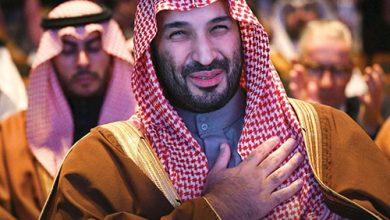ANTI-IRAN FRONT
THE ENEMY OF MY ENEMY
Yasmin Helal analyses the nuances of President Donald Trump’s recent visit to the Middle East

In his first diplomatic mission as President of the United States, Donald Trump hopped on a plane to travel to where some believe to be the most dangerous region on Earth.
In the divisive world of the Middle East, he sided with the Sunnis against Iranian Shiites. It seems to have escaped him that terrorist groups like ISIS and Al-Qaeda, which are targeting the West, are on the Sunni side and that Russia – with which he has been longing to strengthen ties – is with Iran. Shortly after he landed in Saudi Arabia, Trump dropped his infamous anti-Islam rhetoric and said that Islam is one of the world’s greatest faiths – this in spite of his twice-unsuccessful attempts to ban people from Muslim-majority states from visiting the US.
Standing before King Salman of Saudi Arabia as well as other local and regional politicians, Trump said: “We signed historic agreements with the kingdom that will invest almost US$ 400 billion in our two countries, and create many thousands of jobs in America and Saudi Arabia.”
He continued: “This landmark agreement includes the announcement of a US$ 110 billion Saudi-funded defence purchase.” Maybe the dollar signs helped him temporarily desist from hostile rhetoric against Islam and Muslims.
The kingdom’s monarchs seemed pleased as they listened intently to his speech but the truth is that they were aiming for more than merely the usual import of American weapons.
They wanted a world power to share their hostility towards Iran as the deal signed between Iran’s leadership and the Obama administration had been a thorn in their flesh. Not only did it threaten the entire Gulf, the deal also relieved Iran from oil production cuts while others in the region had to abide by them and lost precious market share. Trump has been a strong opponent of the deal that marked the first communication between the White House and Iran since the 1979 revolution. So much so that his plan to reverse the deal was one of the central themes in his election campaign last year.
For his part, Iranian President Hassan Rouhani reminded Trump that the deal is non-negotiable regardless of how the latter feels about it. According to Rouhani, reneging on the deal is not possible as it is a multilateral agreement that was co-signed by Britain, China, France, Germany and Russia.
At a press conference commemorating the anniversary of the deal’s implementation in Tehran, Rouhani said that talk of renegotiating it “is like saying that we should turn a shirt back to cotton.”
Trump may be unable to renegotiate the deal but he can certainly look for another way to trap Iran. His speech in Riyadh was littered with threats: “Until the Iranian regime is willing to be a partner for peace, all nations of conscience must work together to isolate Iran, deny it funding for terrorism and pray for the day when the Iranian people have the just and righteous government they deserve.”
In a bid to win his battle against Iran, Trump carefully planned his agenda for the trip. Another regional player who would love to see Iran go up in flames, Israel was his second stop. By inviting the Saudis and Israelis to enter into peace talks, he hopes to bring the two Iran-haters together.
But resolving the Israel-Palestine conflict isn’t that easy – certainly not for a novice politician like Trump.
The Saudi kingdom had engaged in similar talks in the past, launching the Arab Peace Initiative in 2002 that called for peace between Arab nations and Israel. But this can only be realised under certain conditions to which Israel has repeatedly refused to agree – for example, its withdrawal to truce lines before the 1967 Arab-Israeli War and the establishment of a Palestinian state with East Jerusalem as its capital.
On the other hand, some argue that recent developments in the region might have reshuffled the priorities of local leaders. Following the Arab Spring in 2011 with Syria, Libya, Yemen and Iraq being destroyed by war, the Palestinian case is no longer at the top of the agenda in the region.
Shortly following the Arab Spring, the Gulf region was consumed by the emergence of low oil prices, not to mention the growing rivalry with Iran that was blamed for civil conflicts in Bahrain, Kuwait, Syria and Yemen. While a notable diplomatic distance is being maintained between Israel and the Gulf states, Israel’s military might and intelligence capability could perhaps be more appreciated given the regional circumstances.
Even though some doubt that Trump is the right man for the job, it might be the right time for him to broker peace between Israel and the rest of the region – something that no other US president has been able to achieve – through the common goal of destroying a common enemy.
As a proud white nationalist, Trump is following in the footsteps of many of his ancestors. They played the same game following the end of World War II – crush the Jews and pit them against the Arabs: divide and conquer.
Today, the strategy could be to reunite the Sunnis and Jews, and pit them against the Shiites.
But before Trump proceeded to Israel, he reminded the Saudis who the boss is by quipping: “Working alongside another beloved leader – American President Franklin Roosevelt – King Abdulaziz began the enduring partnership between our two countries. King Salman, your father would be so proud to see that you are continuing his legacy.”






